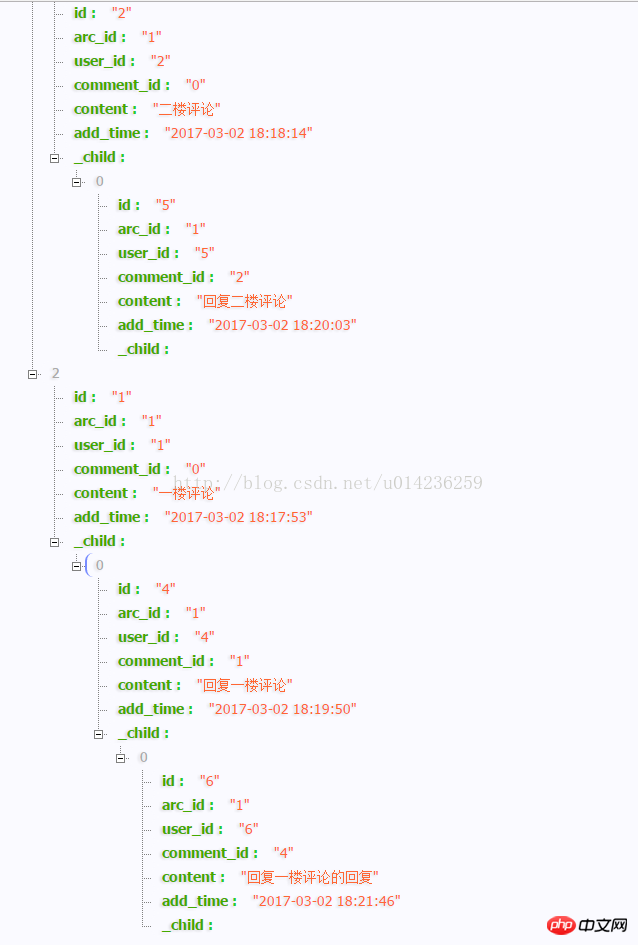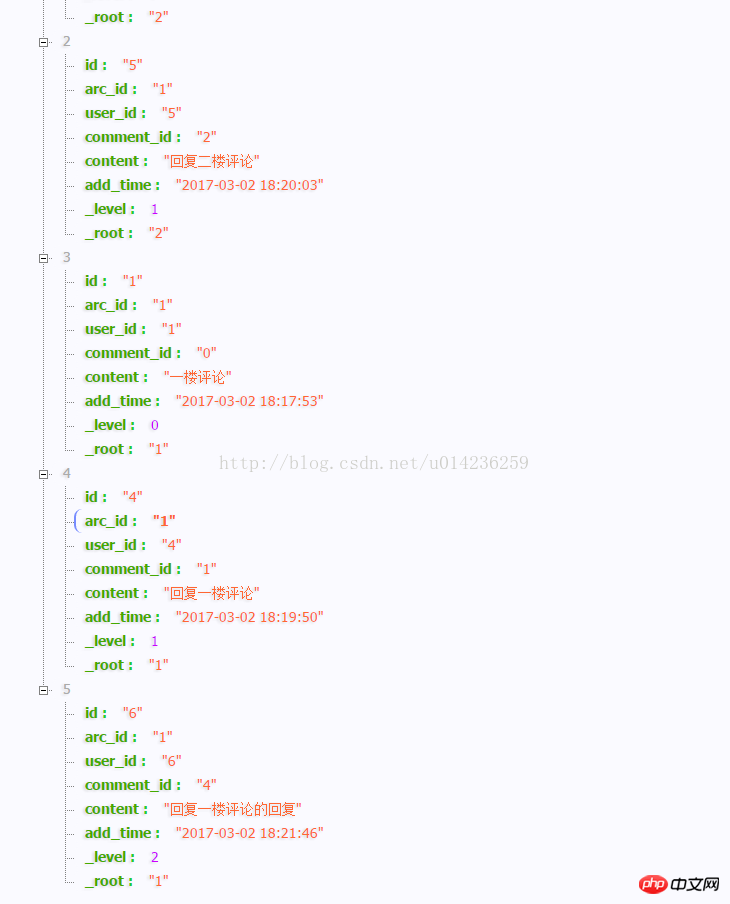PHP development article comment system
I recently needed to complete a comment function at work, and I searched online for several display styles of the comment system. Finally, with reference to comment systems such as "Duosuo" and "Changyan", I implemented a simple comment system using PHP language. The implementation process of the two methods (recursive and non-recursive) is recorded, and the advantages and disadvantages of the two methods are analyzed, but how the front-end is implemented is not shown.
First design the database as follows:
create table `comments`( `id` bigint unsigned not null AUTO_INCREMENT, `arc_id` bigint unsigned not null COMMENT '文章id', `user_id` bigint unsigned not null COMMENT '用户id', `comment_id` bigint unsigned not null DEFAULT '0' COMMENT '回复某个评论的id', `content` varchar(255) not null DEFAULT '' COMMENT '评论或回复的内容', `add_time` timestamp not null DEFAULT CURRENT_TIMESTAMP COMMENT '添加时间', PRIMARY KEY (`id`), KEY `arc_id` (`arc_id`) )ENGINE=InnoDB DEFAULT CHARSET=utf8 COMMENT '文章评论表';
Create test data as follows:

The specific implementation plan is as follows (in Implemented on the ThinkPHP framework):
1. Recursive method
Advantages: The implementation code is simple, and if the level of comments is fixed at five levels or less, it is recommended to use this method, so that the front-end can easily implement this data result .
Disadvantages: If the level of comments is not fixed, the front end will not be able to display the comment information, and if there are too many levels, it will consume a lot of memory. What’s more terrible is that every recursion has to query the database, and the performance will be reduced. Greatly reduced.
/**
* @param $arc_id 文章id
* @param int $comm_id 评论id
* @param array $result
* @return array
*/
function getCommlist($arc_id, $comm_id = 0, &$result = array()){ //获取评论列表
if(empty($arc_id)){
return array();
}
$_where = "arc_id = {$arc_id} AND comment_id = {$comm_id}";
$res = M('comments')->where($_where)->order('add_time DESC')->select();
if(empty($res)){
return array();
}
foreach ($res as $cm) {
$thisArr = &$result[];
$cm["_child"] = getCommlist($arc_id,$cm['id'],$thisArr);
$thisArr = $cm;
}
return $result;
}Part of the data is displayed as follows:

#2. Non-recursive method (stack method implementation)
Advantages: only query A primary database has better performance. N-level comments can be realized, and the front-end can also display them well.
Disadvantages: The code is slightly complicated. For fixed-level comments, the front-end display of comments is more complicated.
/**
* @param $arc_id 文章id
* @return array
*/
public function getCommlist($arc_id){
if(empty($arc_id)){
return array();
}
$res = M('comments')->where(array('arc_id'=>$arc_id))->order('add_time ASC')->select();
$dataList = $stack = array();
if($res){
foreach($res AS $k=>$v){ //先将评论的数据进行入库(即comment_id=0)
if($v['comment_id'] == 0){
$v['_level'] = 0; //设置层级数
$v['_root'] = $v['id']; //标识评论id
array_push($stack,$v); //入栈
unset($res[$k]);
}
}
while(!empty($stack)){
$node = array_pop($stack); //出栈
$dataList[] = $node;
foreach($res as $_k=>$_v){
if($_v['comment_id'] == $node['id']){
$_v['_level'] = $node['_level']+1; //设置层级数
$_v['_root'] = $node['_root']; //标识评论id
array_push($stack,$_v); //入栈
unset($res[$_k]);
}
}
}
}
return $dataList;
}The data display effect is as follows:

The above is the detailed content of PHP development article comment system. For more information, please follow other related articles on the PHP Chinese website!

Hot AI Tools

Undresser.AI Undress
AI-powered app for creating realistic nude photos

AI Clothes Remover
Online AI tool for removing clothes from photos.

Undress AI Tool
Undress images for free

Clothoff.io
AI clothes remover

Video Face Swap
Swap faces in any video effortlessly with our completely free AI face swap tool!

Hot Article

Hot Tools

Notepad++7.3.1
Easy-to-use and free code editor

SublimeText3 Chinese version
Chinese version, very easy to use

Zend Studio 13.0.1
Powerful PHP integrated development environment

Dreamweaver CS6
Visual web development tools

SublimeText3 Mac version
God-level code editing software (SublimeText3)

Hot Topics
 1666
1666
 14
14
 1426
1426
 52
52
 1328
1328
 25
25
 1273
1273
 29
29
 1255
1255
 24
24
 PHP: A Key Language for Web Development
Apr 13, 2025 am 12:08 AM
PHP: A Key Language for Web Development
Apr 13, 2025 am 12:08 AM
PHP is a scripting language widely used on the server side, especially suitable for web development. 1.PHP can embed HTML, process HTTP requests and responses, and supports a variety of databases. 2.PHP is used to generate dynamic web content, process form data, access databases, etc., with strong community support and open source resources. 3. PHP is an interpreted language, and the execution process includes lexical analysis, grammatical analysis, compilation and execution. 4.PHP can be combined with MySQL for advanced applications such as user registration systems. 5. When debugging PHP, you can use functions such as error_reporting() and var_dump(). 6. Optimize PHP code to use caching mechanisms, optimize database queries and use built-in functions. 7
 PHP and Python: Comparing Two Popular Programming Languages
Apr 14, 2025 am 12:13 AM
PHP and Python: Comparing Two Popular Programming Languages
Apr 14, 2025 am 12:13 AM
PHP and Python each have their own advantages, and choose according to project requirements. 1.PHP is suitable for web development, especially for rapid development and maintenance of websites. 2. Python is suitable for data science, machine learning and artificial intelligence, with concise syntax and suitable for beginners.
 PHP vs. Python: Understanding the Differences
Apr 11, 2025 am 12:15 AM
PHP vs. Python: Understanding the Differences
Apr 11, 2025 am 12:15 AM
PHP and Python each have their own advantages, and the choice should be based on project requirements. 1.PHP is suitable for web development, with simple syntax and high execution efficiency. 2. Python is suitable for data science and machine learning, with concise syntax and rich libraries.
 PHP in Action: Real-World Examples and Applications
Apr 14, 2025 am 12:19 AM
PHP in Action: Real-World Examples and Applications
Apr 14, 2025 am 12:19 AM
PHP is widely used in e-commerce, content management systems and API development. 1) E-commerce: used for shopping cart function and payment processing. 2) Content management system: used for dynamic content generation and user management. 3) API development: used for RESTful API development and API security. Through performance optimization and best practices, the efficiency and maintainability of PHP applications are improved.
 The Enduring Relevance of PHP: Is It Still Alive?
Apr 14, 2025 am 12:12 AM
The Enduring Relevance of PHP: Is It Still Alive?
Apr 14, 2025 am 12:12 AM
PHP is still dynamic and still occupies an important position in the field of modern programming. 1) PHP's simplicity and powerful community support make it widely used in web development; 2) Its flexibility and stability make it outstanding in handling web forms, database operations and file processing; 3) PHP is constantly evolving and optimizing, suitable for beginners and experienced developers.
 PHP vs. Other Languages: A Comparison
Apr 13, 2025 am 12:19 AM
PHP vs. Other Languages: A Comparison
Apr 13, 2025 am 12:19 AM
PHP is suitable for web development, especially in rapid development and processing dynamic content, but is not good at data science and enterprise-level applications. Compared with Python, PHP has more advantages in web development, but is not as good as Python in the field of data science; compared with Java, PHP performs worse in enterprise-level applications, but is more flexible in web development; compared with JavaScript, PHP is more concise in back-end development, but is not as good as JavaScript in front-end development.
 PHP and Python: Different Paradigms Explained
Apr 18, 2025 am 12:26 AM
PHP and Python: Different Paradigms Explained
Apr 18, 2025 am 12:26 AM
PHP is mainly procedural programming, but also supports object-oriented programming (OOP); Python supports a variety of paradigms, including OOP, functional and procedural programming. PHP is suitable for web development, and Python is suitable for a variety of applications such as data analysis and machine learning.
 PHP and Python: Code Examples and Comparison
Apr 15, 2025 am 12:07 AM
PHP and Python: Code Examples and Comparison
Apr 15, 2025 am 12:07 AM
PHP and Python have their own advantages and disadvantages, and the choice depends on project needs and personal preferences. 1.PHP is suitable for rapid development and maintenance of large-scale web applications. 2. Python dominates the field of data science and machine learning.




